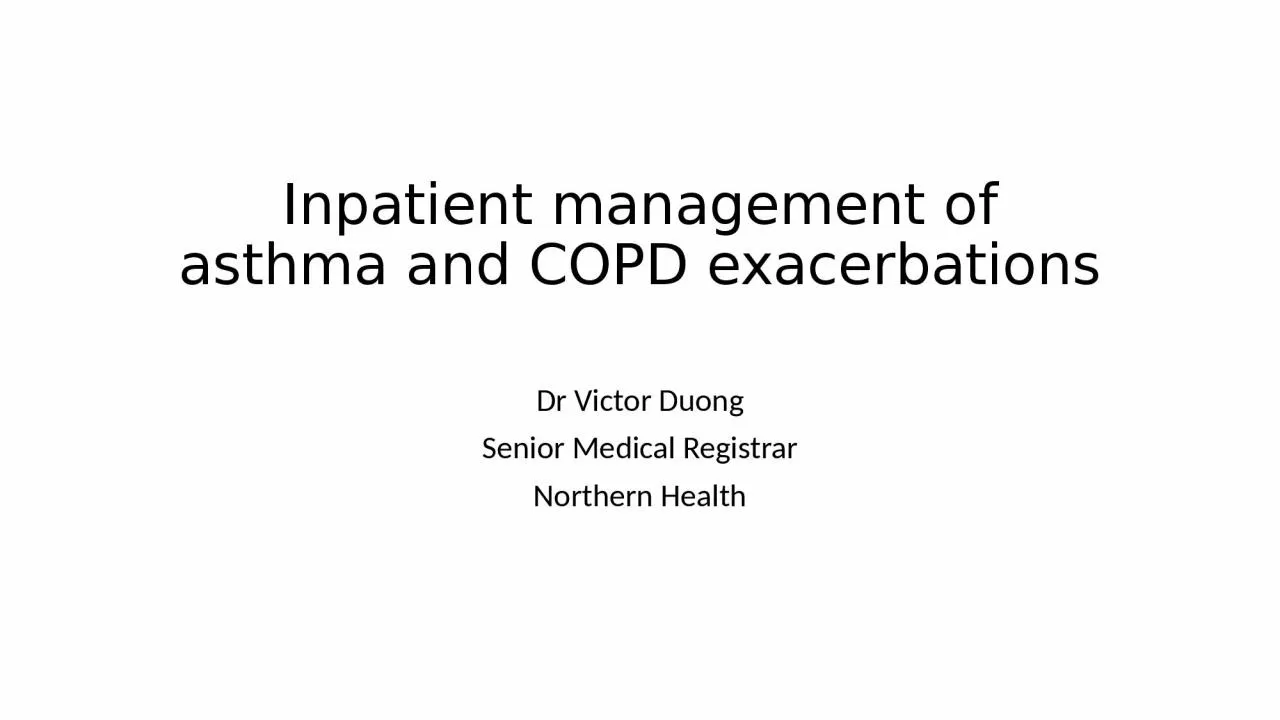

Dr Victor Duong Senior Medical Registrar Northern Health Asthma Overview Initial assessment and management in the ED Inpatient management Preparing for discharge What is not covered Diagnostic aspects ID: 1033438
Download Presentation The PPT/PDF document "Inpatient management of asthma and COPD ..." is the property of its rightful owner. Permission is granted to download and print the materials on this web site for personal, non-commercial use only, and to display it on your personal computer provided you do not modify the materials and that you retain all copyright notices contained in the materials. By downloading content from our website, you accept the terms of this agreement.
1. Inpatient management of asthma and COPD exacerbationsDr Victor DuongSenior Medical RegistrarNorthern Health
2. Asthma
3.
4. OverviewInitial assessment and management in the EDInpatient managementPreparing for discharge
5. What is not coveredDiagnostic aspectsManagement in the communityInhalers and escalationBiologics
6. Initial assessmentFocussed history and examination in conjunction with initiation of treatmentTake note of features that suggest severe asthma exacerbation or features suggesting either an alternate or comorbid condition
7. Features suggesting severe asthma exacerbation:RR >30/minHR >120/minAccessory muscle useDiaphoresisInability to speak in full sentences of phrasesInability to lie supinePulsus paradoxus (fall in BP by >10 mmHg during inspiration)
8. Features suggesting an alternate or comorbid diagnosis:FeverPurulent sputum productionUrticariaPleuritic chest pain
9. Peak flow measurementIn general, peak flow <200 L/min indicates severe obstructionIf personal best known, ≤50% of this (or predicted) defines severe obstruction – after initial bronchodilator therapy
10. Arterial blood gasesRespiratory drive invariably increased in acute asthma hyperventilation decreased PaCO2A normal PaCO2 indicates decreasing alveolar ventilation and tidal volume Hypercapnia and respiratory failure can develop with any further airway narrowing or respiratory muscle fatigueProgressive hypercapnia usually requires intubation
11. Chest X rayGenerally not required in the emergency settingHowever, mandatory if being admitted to hospitalAlso if complicating cardiopulmonary process/infection is suspected or when diagnosis uncertainHave low threshold for doing an X ray
12. Management in the EDBronchodilator therapy:Nebulised salbutamol 2.5-5.0 mg q20m or MDI+spacer 6-12 puffs q20mCan alternate with ipratropium bromide in first hour – 500 mcg via nebuliser q20m or 6-12 puffs MDI+spacer q20mSteroidPrednisolone 50 mg orally or alternativeOxygenTitrate SpO2 92-96%Magnesium sulphate2 g IV over 20 mins for life-threatening exacerbations and exacerbations that remains severe after an hour of bronchodilator therapy
13.
14. Nebuliser vs MDI + spacerRelatively large particle size generated by jet nebuliser and loss of drug via expiratory port of nebuliser system inefficientMultiple trials comparing efficacy of nebuliser vs MDI + spacer (in much smaller doses) comparable outcomesNebuliser may be reasonable to use in ED due to simplicity of delivery during patient’s tidal breathing
15. Advantages of MDI + spacer vs nebuliserCheaper to use in communityImproved lung deposition of drugReduce adverse effects of beta-2 agonist therapyNo aerosolization of infective particles
16. Inpatient careMonitorTaper SABATransition to MDI + spacerResume previous inhalers as soon as able*Check inhaler techniqueSmoking cessation
17. Empiric antibiotics in asthma exacerbationsCurrent guidelines advise against empiric antibiotics in asthma exacerbationsA recent database study of 19,811 patients (JAMA Intern Med, 2019) found that almost half of patients hospitalised for an asthma exacerbation received antibiotics during the first two hospital days – patients with infection were excludedMedian hospital stay was longer when compared to antibiotic-untreated patients with no difference in treatment failure
18. DischargeOral steroidsPrednisolone 7-14 daysNo need to taper if course <14 daysInhaled steroidsContinue and ensure complianceCommence if first episode or if not previously takingSABA – as requiredOR Symbicort SMARTRespiratory OPD, RFTs, additional testing as indicated
19. Asthma Action PlanRequired on discharge for every patientAims:Better asthma controlFewer asthma exacerbationsFewer days off workReduced reliver medication useFewer hospital admissions
20.
21.
22. COPD
23.
24. OverviewInitial assessment and management in the EDInpatient managementPreparing for discharge
25. What is not coveredDiagnosisOutpatient escalation of inhalersNon-invasive ventilation in the community, long-term antibiotics, vitamin D
26. Initial assessmentHistory should clarify:Time course of symptomsBaseline ETSeverity of symptomsSputum characteristicsOther: Constitutional symptoms, chest pain, peripheral oedema, risk factors for PE, URTI symptomsPast medical history, including severity of COPD and lung functionExamination:Looks for features that suggest severity and those that suggest alternative/comorbid diagnosis
27. Blood gasAll patients presenting with a COPD exacerbation should have a blood gasCan start with a VBGIf pH ≤7.32, proceed to ABGCXRECGBloodsPeak flow measurement not useful in COPD
28. ED managementBronchodilatorSalbutamol +/- ipratropiumSteroid25-50 mg prednisolone or equivalentOxygenIf in doubt, aim 88-92%Beware significant hypoxiaAntibioticsNIVGOPC
29. AntibioticsDo not use antibiotics unless there are clinical features suggestive of bacterial infectionIncreased sputum volumeIncreased sputum purulenceFeverIf antibiotics are indicated, use:Amoxicillin 500 mg TDS 5/7Amoxicillin 1 g BD 5/7Doxycycline 100 mg daily 5/7*Avoid Augmentin for initial antibiotic treatment of COPD exacerbation
30. Non-invasive ventilationStandard of care in patients with acute respiratory acidosisReduces rate of intubationReduces mortalityDecreased length of hospital stayCan only be done in ED, ICU and RCU
31. Inpatient careWean bronchodilators/NIVRecommence usual inhalers and switch to MDI + spacerCease ipratropiumCheck inhaler technique!!!CNC review if requiredDVT prophylaxisSmoking cessationNutritional supportConsider allied health referralPalliative care medications
32. DischargePrednisolone 5/7Antibiotics 5/7Inhalers – ensure correct techniquePulmonary rehabilitationConsider HARP referralConsider Action PlanResp OPD/lung functionHome oxygen
33. Pulmonary rehabilitationImproves quality of lifeImproves exercise toleranceReduces hospital readmissionsNo effect on mortality
34. Management of asthma vs COPDAsthmaSABA, systemic glucocorticoidNo antibioticsAdjunct – magnesiumT2RF intubationPrednisolone 7-14 daysICS on dischargeAction Plan mandatoryCOPDSABA, systemic glucocorticoidAntibiotics sometimes indicatedNo adjunctive therapyT2RF NIV intubationPrednisolone 5 daysICS if recurrent flaresAction Plan in selected patients
35.
36.
37. ReferencesUpToDateAustralian Asthma HandbookCOPD-X GuidelinesTherapeutic Guidelines